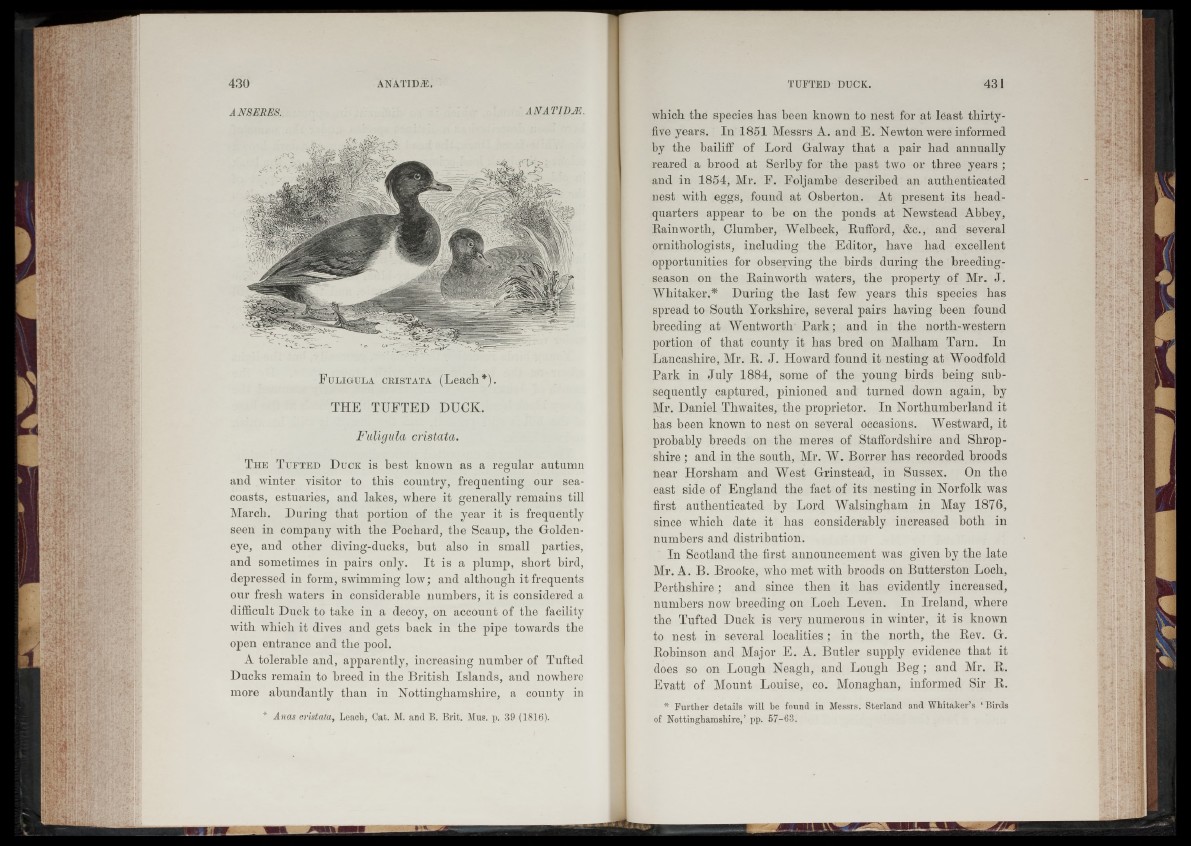
A NS ER ES. A NATH)JA
F u l ig u l a ckistata (Leach*).
THE TUFTED DUCK.
Fuligula cristata.
T h e T u f t e d D uck is best known as a regular autumn
and winter visitor to this country, frequenting our sea-
coasts, estuaries, and lakes, where it generally remains till
March. During that portion of the year it is frequently
seen in company with the Pochard, the Scaup, the Goldeneye,
and other diving-ducks, hut also in small parties,
and sometimes in pairs only. It is a plump, short bird,
depressed in form, swimming low; and although it frequents
our fresh waters in considerable numbers, it is considered a
difficult Duck to take in a decoy, on account of the facility
with which it dives and gets back in the pipe towards the
open entrance and the pool.
A tolerable and, apparently, increasing number of Tufted
Ducks remain to breed in the British Islands, and nowhere
more abundantly than in Nottinghamshire, a county in
* Anas cristata, Leach, Cat. M. and B. Brit. Mus. p. 39 (1816).
which the species has been known to nest for at least thirty-
five years. In 1851 Messrs A. and E. Newton were informed
by the bailiff of Lord Galway that a pair had annually
reared a brood at Serlby for the past two or three years ;
and in 1854, Mr. F. Foljambe described an authenticated
nest with eggs, found at Osberton. At present its headquarters
appear to be on the ponds at Newstead Abbey,
Rainwortli, Clumber, Welbeck, Rufford, &c., and several
ornithologists, including the Editor, have had excellent
opportunities for observing the birds during the breeding-
season on the Rainworth waters, the property of Mr. J.
Whitaker.'*' During the last few years this species has
spread to South Yorkshire, several pairs having been found
breeding at Wentworth Park; and in the north-western
portion of that county it has bred on M.alham Tarn. In
Lancashire, Mr. R. J. Howard found it nesting at Woodfold
Park in July 1884, some of the young birds being subsequently
captured, pinioned and turned down again, by
Mr. Daniel Thwaites, the proprietor. In Northumberland it
has been known to nest on several occasions. Westward, it
probably breeds on the meres of Staffordshire and Shropshire
; and in the south, Mr. W. Borrer has recorded broods
near Horsham and West Grinstead, in Sussex. On the
east side of England the fact of its nesting in Norfolk was
first authenticated by Lord Walsingliam in May 1876,
since which date it has considerably increased both in
numbers and distribution.
In Scotland the first announcement was given by the late
Mr. A. B. Brooke, who met with broods on Butterston Loch,
Perthshire; and since then it has evidently increased,
numbers now breeding on Loch Leven. In Ireland, where
the Tufted Duck is very numerous in winter, it is known
to nest in several localities; in the north, the Rev. G.
Robinson and Major E. A. Butler supply evidence that it
does so on Lough Neagh, and Lough Beg ; and Mr. R.
Evatt of Mount Louise, co. Monaghan, informed Sir R.
* Farther details will be found in Messrs. Sterland and Whitaker’s 1 Birds
of Nottinghamshire,’ pp. 57-63.